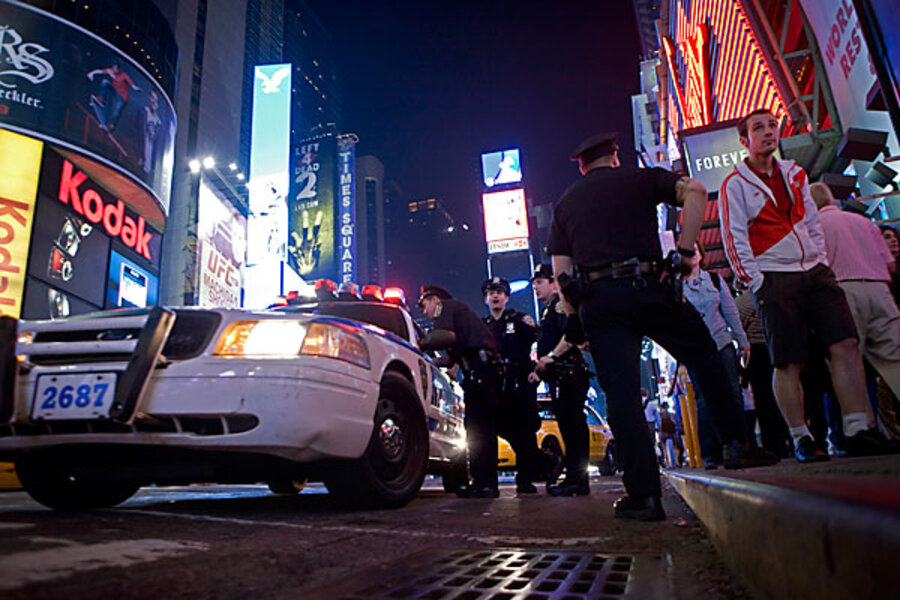Why the Times Square bomb failed spectacularly
Loading...
| Washington
Why didn’t the Times Square bomb explode? It failed to go off because it was both badly constructed and poorly designed, say experts.
The homemade bomb – discovered as it fizzled and smoked at a landmark US crossroads – was a strange combination of ingredients, notes John Pike, head of GlobalSecurity.org.
It was composed of gasoline, propane tanks, fertilizer, and consumer-grade fireworks, according to information released by New York City police. But gasoline does not explode – it burns. Propane does explode, but only when mixed with air in precise quantities. And the fertilizer doesn’t appear to have been mixed with fuel oil, which is a prerequisite to making the sort of fertilizer explosive with which Timothy McVeigh destroyed the Oklahoma City federal building.
Even bungled attacks can be serious, however.
“Just because [the perpetrator or perpetrators] was incompetent doesn’t mean they didn’t have evil intent,” says Mr. Pike.
Alarm clock and fireworks
According to police, the detonating agent of the car bomb was a cheap-looking alarm clock attached to a 16-ounce can of fireworks – the sort of small explosives one can buy at roadside stands in certain states before the Fourth of July.
New York's mayor noted that the fireworks could have been purchased in Pennsylvania and driven into New York City. The wiring linking the bomb’s parts together appeared crude, he said.
“It looked amateurish, I think, is a nice way to phrase it,” Mayor Michael Bloomberg told reporters following the attack.
The fireworks were supposed to detonate gasoline cans and propane tanks packed in the sport utility vehicle used for this wheel-borne improvised explosive device (IED). The final piece in the hoped-for chain reaction of the bomb was a larger box – a gun locker – filled with 200 to 250 pounds of fertilizer.
Initial police reports indicate that the fertilizer was not the grade of ammonium nitrate used by Mr. McVeigh to terrible effect. McVeigh’s bomb, at some 4,000 pounds, was also much larger.
'Call it a terrorist act'
But even a small bomb, properly constructed, could have caused havoc in the close quarters of Times Square. To park a car bomb there shows that the perpetrator was intending to make a statement and cause the maximum amount of damage possible, says Pike.
To him, that’s terrorism, whether of domestic or international origin.
“I would go ahead and call it a terrorist act,” he says.
In a series of broadcast appearances on Monday, Secretary of Homeland Security Janet Napolitano said the US is not ruling anything in or anything out as it investigates the case.
“Right now, every lead has to be pursued,” said Secretary Napolitano on NBC’s “Today” show.
However, White House spokesman Robert Gibbs said Monday that whoever had tried the attack had intended to terrorize New Yorkers.
“I would say that whoever did that would be categorized as a terrorist,” said Mr. Gibbs at the White House briefing.
There's plenty of evidence for investigators to work with, because the SUV-bomb did not go off.
Terrorism via easy-to-obtain ingredients
Propane and gasoline have been used in terrorist attacks before. In June 2007, a British-born Muslim doctor radicalized by the war in Iraq used propane, gas, and nails in a series of attempted car bombs in London and Glasgow. They failed to detonate.
But easily obtainable ingredients can still be mixed to deadly effect. Backpack bombs made of peroxide and other substances found in hair salons were the weapon used in the 2005 London subway bombings, in which 52 people were killed.
Najibullah Zazi, the Denver airport shuttle bus employee who pleaded guilty to a 2009 plot to attack the New York City subway, was stockpiling material for a peroxide-type explosive, according to US authorities.
Related:





